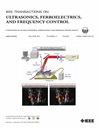BEAS-Net:基于形状先验的深度卷积神经网络,用于二维超声心动图中左心室的稳健分割。
IF 3.7
2区 工程技术
Q1 ACOUSTICS
IEEE transactions on ultrasonics, ferroelectrics, and frequency control
Pub Date : 2024-06-24
DOI:10.1109/TUFFC.2024.3418030
引用次数: 0
摘要
二维超声心动图图像的左心室(LV)分割是分析心脏形态和功能以及诊断心血管疾病的重要步骤。最近提出了几种用于自动分割左心室的深度学习(DL)算法,与传统的分割算法相比,其性能有了显著提高。然而,与传统方法不同的是,在训练深度学习算法时,通常不纳入有关分割问题的先验信息,如解剖形状信息。如果未见图像的特征与训练图像(如低质量测试图像)的特征有一定差异,这可能会降低 DL 模型在未见图像上的泛化性能。本研究引入了一种新的形状约束深度卷积神经网络(CNN),称为 BEAS-Net,用于自动 LV 分割。BEAS-Net 学习如何将其卷积层编码的图像特征与 B 样条显式主动曲面(BEAS)算法得出的解剖形状先验信息联系起来,从而在处理伪图像或低质量图像时生成有生理意义的分割轮廓。我们使用三个不同的体内数据集对所提出的网络性能进行了评估,并与基于 U-Net 模型的深度分割算法进行了比较。在可接受质量的图像上进行测试时,两个网络的结果相当,但在伪图像和低质量图像上,BEAS-Net 的表现优于基准 DL 模型。本文章由计算机程序翻译,如有差异,请以英文原文为准。
BEAS-Net: A Shape-Prior-Based Deep Convolutional Neural Network for Robust Left Ventricular Segmentation in 2-D Echocardiography
Left ventricle (LV) segmentation of 2-D echocardiography images is an essential step in the analysis of cardiac morphology and function and—more generally—diagnosis of cardiovascular diseases (CVD). Several deep learning (DL) algorithms have recently been proposed for the automatic segmentation of the LV, showing significant performance improvement over the traditional segmentation algorithms. However, unlike the traditional methods, prior information about the segmentation problem, e.g., anatomical shape information, is not usually incorporated for training the DL algorithms. This can degrade the generalization performance of the DL models on unseen images if their characteristics are somewhat different from those of the training images, e.g., low-quality testing images. In this study, a new shape-constrained deep convolutional neural network (CNN)—called B-spline explicit active surface (BEAS)-Net—is introduced for automatic LV segmentation. The BEAS-Net learns how to associate the image features, encoded by its convolutional layers, with anatomical shape-prior information derived by the BEAS algorithm to generate physiologically meaningful segmentation contours when dealing with artifactual or low-quality images. The performance of the proposed network was evaluated using three different in vivo datasets and was compared with a deep segmentation algorithm based on the U-Net model. Both the networks yielded comparable results when tested on images of acceptable quality, but the BEAS-Net outperformed the benchmark DL model on artifactual and low-quality images.
求助全文
通过发布文献求助,成功后即可免费获取论文全文。
去求助
来源期刊
CiteScore
7.70
自引率
16.70%
发文量
583
审稿时长
4.5 months
期刊介绍:
IEEE Transactions on Ultrasonics, Ferroelectrics and Frequency Control includes the theory, technology, materials, and applications relating to: (1) the generation, transmission, and detection of ultrasonic waves and related phenomena; (2) medical ultrasound, including hyperthermia, bioeffects, tissue characterization and imaging; (3) ferroelectric, piezoelectric, and piezomagnetic materials, including crystals, polycrystalline solids, films, polymers, and composites; (4) frequency control, timing and time distribution, including crystal oscillators and other means of classical frequency control, and atomic, molecular and laser frequency control standards. Areas of interest range from fundamental studies to the design and/or applications of devices and systems.

 求助内容:
求助内容: 应助结果提醒方式:
应助结果提醒方式:


